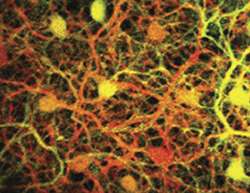New function for rods in daylight

(Medical Xpress)—Vision – so crucial to human health and well-being – depends on job-sharing by just a few cell types, the rod cells and cone cells, in our retina. Botond Roska and his group have identified a novel function for rod photoreceptor cells in the retina in daylight. Driven by cones and mediated by horizontal cells, rods help to increase contrast information at times when they are not directly sensing light. The retina thus repurposes its cells in different light conditions to increase the amount of visual information about the environment.
Task sharing in the retina seemed clear: Two different kinds of photoreceptor cells take on two different visual tasks. Rods allow us to see at night, cones operate during the day and enable color vision. However, the question as to why there are about 20 times more rods than cones in a human retina, when daytime vision is much more relevant for us, has usually led to a shrug of shoulders. It seemed a waste of resources.
Botond Roska and his group at the Friedrich Miescher Institute for Biomedical Research, could now show in a study published recently in Nature Neuroscience that the rods in mouse take on an important function during daytime vision as well.
The scientists showed that in bright light, the rods mediate a so called surround inhibition. Surround inhibition is an important feature in the retina because it allows not only to transmit information about whether a photoreceptor is exposed to light, but also about contrast. While the cone cells hyperpolarize in bright light and thus send a visual signal to the inner retina, the rods depolarize, inversely matching the activity pattern of the cone cells. The response in the rods is driven by cone cells and mediated through horizontal cells. These horizontal cells connect rods and cones through their dendrites and long axons, and at the same time form a mesh of connections among each other. The hyperpolarization of one cone thus leads to the depolarization of many surrounding rods.
During bright light conditions, the cells of the inner retina receive therefore information through two pathways: First through the well-established cone pathway, and second through this newly identified rod pathway. "We think that the surround information relayed to the inner retina through the rod pathway has different functional properties than the information obtained through the cone pathway," comments Roska. "In any case it is fascinating to see how the retina repurposes the rod cells during bright light conditions to increase contrast information, at times when they are not directly sensing light."
After all, these large numbers of rods don't seem to be present in the retina in vain.
More information: Szikra T, Trenholm S, Drinnenberg A, Jüttner J, Raics Z, Farrow K, Biel M, Awatramani G, Clark DA, Sahel JA, da Silveira RA, Roska B. "Rods in daylight act as relay cells for cone-driven horizontal cell-mediated surround inhibition." Nat Neurosci. 2014 Oct; [Epub ahead of print], www.nature.com/neuro/journal/v … nt/full/nn.3852.html




















